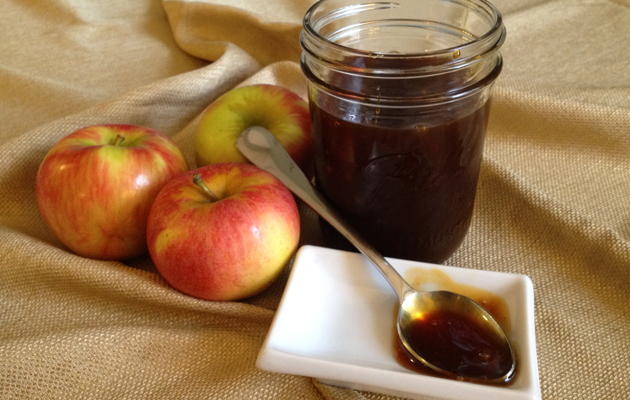Last year, when I got a SodaStream, I started mixing various juices with seltzer to make fruity spritzers. A favorite in this house is equal parts apple cider and seltzer with a couple spoonfuls of ginger ale syrup. It’s autumn in a glass.
But I’m fussy about my fruits; I won’t eat apples out of season. As soon as the trees stop producing, I cut off my daily apple consumption, and that includes putting the kibosh on buying jugs of cider. I really make the most of my fall cider purchases, and I once experimented with cooking it down to make a syrup for Saturday-morning pancakes. I had some leftover and I stirred it into soda water. What wizardry had I unlocked?
Nothing my ancestors hadn’t already well-documented, it turns out, but it’s a treasure all the same. It turns out that Colonial New Englanders—no slouches in the department of preserving the harvest—knew exactly how to extend the delicious, tangy joy of cider so that it could last year-round. By cooking cider down, reducing it to one-seventh its original volume, you concentrate the sugars, capture the sweet-tart nature of the juice, and make something that lasts at least a year if refrigerated (though I’m sure our Colonial predecessors didn’t worry about that last part). With apples being as plentiful as they were, boiled cider was one of the cheapest sweeteners available (not to mention the tastiest).
This recipe falls in the “set it and forget it” category. It involves no complicated appliances, only a single ingredient, and nothing but a little time in the house. Simply put, boiled cider (or apple cider molasses, or cider syrup) is fresh apple cider that is cooked down until thick and syrupy. That’s it. There’s no trick to it, it’s just a simple trick.
Now, why would you want to do this? Aside from the fact that it makes your house smell incredible (and seriously, I mean incredible), the resulting syrup has a number of applications both savory and sweet.
- Stir it into seltzer for an awesome soda treat long after the apple harvest (apple soda in May!).
- Add it to boiling water to make hot cider after a long wintry walk.
- Brush it on raw bacon strips and roast for a candied bacon that’s out of this world.
- Mix it into the dough for baked goods, like scones, cake, and donuts, to add cider flavor and cut refined sugar.
- Toss apples with it to bake in a pie. If you want to blow someone’s balls off with the awesome appletude of your pie, do this. Trust me.
- Warm it and drizzle it over ice cream (pumpkin ice cream is a particular treat).
- Add a bit to your baked beans.
- Swirl it in your morning oatmeal or yogurt.
- Glaze roasted squash or carrots.
- Whisk it into a vinaigrette.
- Put it on pancakes in place of maple syrup.
- Spread it on buttered toast.
- Make a PB & boiled cider sandwich. Vow to never use ordinary jelly again.
- Glaze ham or chicken.
- Add some to a gravy for pork.
- Stir into hot tea.
- Add to cocktails (rum, whiskey, brandy).
- Use it to make BBQ sauce.
- Stir it into cream cheese and put it on a bagel or a slice of pumpkin bread.
Are you excited yet?
Boiled Cider / Apple Cider Molasses / Cider Syrup
Active time: 10 minutes | Total time: 3 1/2 to 5 hours | Yield: approximately 2 1/4 cups
Ingredients
1 gallon fresh apple cider
Instructions
- In a clean, nonreactive pot, add 2 1/4 cups cider. Stick a skewer into liquid and mark the height by drawing on skewer with a pen or wrapping it with a rubber band. This will be the way you measure how much the cider has reduced (2 1/4 cups is approximately 1/7 of a gallon). Add the rest of the cider and heat over medium-high. (If desired, add spices at this time.) After 30 to 45 minutes, use a spoon to skim off any foam around the edges.
- Keep cider at a rapid simmer for 3 1/2 to 5 hours. Every hour, stick a second, clean skewer in the pot, take note of the height of the liquid and compare it to your marked skewer.
- When the level of cider is near the mark on your skewer, stir every 5 to 10 minutes, making sure liquid does not bubble over. When it has reduced to 1/7 original volume (it should coat the back of a spoon and be the consistency of warm maple syrup), remove from heat and pour into a clean glass jar (if you wish, strain it through a fine-mesh sieve first). Let cool to room temperature, seal, and refrigerate, up to 1 year.
A note about spices: Traditionally, boiled cider is made without any additional flavorings, as spices can muddy the flavor and also turn the syrup an unsightly color during the long cook time. If you want to add spices, try 1 cinnamon stick, 9 peppercorns, a few allspice berries, 2 whole cloves. Remove spices after 2 hours to prevent overconcentrating their flavor.
A note about reducing too much: If you boil your syrup too long, don’t panic. Apples contain a ton of pectin, which is what makes fruit jell, so if you overboil your syrup you just get cider jelly! You can either keep it that way (and usually, I do—the applications for the jelly are almost identical to the regular, more liquidy boiled cider, and it’s even better for putting on bread or PB sandos) or add a little water and thin it back out a tad.



 Subscribe!
Subscribe!